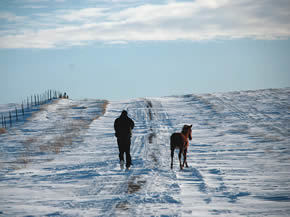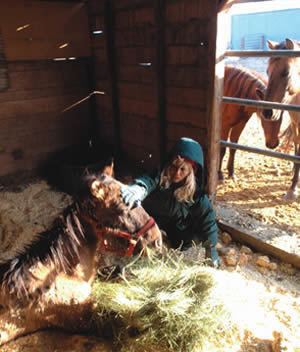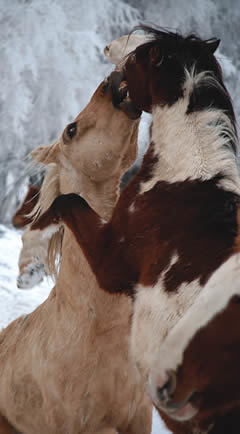
I can’t think of a time when I wasn’t captivated by horses. I did much of my growing up on a rural farm in the Catskill Mountains of New York that was worked with horses long into the modern age, much as the Amish still do today. When they weren’t being worked, the horses ran wild in the pastures, and I ran with them. We had great summers together.
These days horses are still on my mind. I figure nothing will remain wild in the world today. Population growth, development, human greed and demands on the environment mean the only places wild animals will be safe is on reserves. That is likely true for the last of the wild mustangs living on federal lands in the western United States.
The wild mustangs called Sorraias (or Marismenos) were brought to the Americas first by Columbus and then in 1519 by Cortez into Mexico. While a diminishing few of those mustangs whose DNA tests back to the original horses still run on public lands in the United States, managed by agencies of the Department of Interior, maybe 200 remain in scattered herds in Utah, Montana and Oregon. Some are kept semi-wild in South Dakota on private reserves. Another 150 or so run on private lands in Portugal, where the breed was native to the Iberian peninsula.
All of this wild mustang interest is what landed me in South Dakota last winter, just as bitter winds, falling snow and a piercing dry Arctic cold arrived.
Karen Sussman also loves horses. While living in Scottsdale, Arizona, Sussman learned about the work of Velma Johnston, known as Wild Horse Annie. So she joined Johnston’s International Society for the Protection of Mustangs and Burros (ISPMB) as a volunteer, becoming president of the charity in 1989.
Then she did an amazing thing. Starting in 1999, Sussman began arranging for the ISPBM to take possession of bands of wild horses — some of mixed breeds, but also some herds of Sorraia and of Spanish mustangs.
Today, at her ranch in Lantry, South Dakota, Sussman oversees about 500 wild horses. She has been able to keep the herds and the bloodlines intact. No one else has done that.
Last winter, however, Sussman, then 63, was alone with no one to help her. Her hired hand didn’t show up, and volunteers weren’t available. It was the dead of winter. She had a wedding to go to in Arizona, wanted to spend Christmas in Scottsdale with her three grandchildren and needed to attend a horse birth-control clinic in Montana.
Sussman was desperate. She couldn’t leave 500 horses, two dogs and eight cats unattended. An orphaned foal had to be fed every two to three hours, sick horses had to be medicated twice a day and old-timers needed special feed.
She called me, a longtime supporter of her cause.
I asked my friend Myriam Moran if she wanted to go. It didn’t take much contemplation. We flew from Pennsylvania into Rapid City. Sussman met us at the airport. The pickup was full of supplies. “I’m tired. I think you’ll have to drive.”
The drive takes 2½ hours. By the time we got into bed it was 5 a.m. “Sleep in,” were the last words Sussman spoke. She fed the cats, let the dogs out. We slept in until 8 a.m.
Sussman gave us a quick orientation then headed to Montana. Cold winds howled, snow fell, temperatures dropped to minus 21. It was beautiful. Hoary frost dangled from barbed wire. Horse hair, tangled in the barbs, hung like frosty threads. Mustangs came up to the fences to snort and inquire of these two strangers in their midst.
It was the horses most in need that got first care. I crushed horse pills in an electric coffee bean machine and mixed it in their feed. Measured feed into pails. We started the feeding ritual.
There was no easy way to do chores. Sussman’s gates all seemed to have tricks of their own. Stallions were tucked in pens that needed access through other horses. Special-needs horses had to be fed in corrals that could be reached only by walking through a wild herd. Carrying a bale of hay through a bunch of mustangs is like dangling meat in front of piranhas.
Our problems multiplied. Some gates didn’t open at all, so we’d throw hay over then climb in. Two of the water hydrants were frozen solid. This meant we had to carry water in 5-gallon pails from a working hydrant to horses penned up alone or in small groups.
We used an iron bar to break the ice in water troughs. It was like hitting solid mass. Sometimes we were able to break a hole in the ice. Sometimes we gave up and carried water. The mustangs waited patiently. Our reward was watching them drink.
When chores were done around the home place we got in Sussman’s well-used 1992 Ford F-150 and drove two miles or so to the south range to check on the Sorraias. The creek bed was frozen. Cottonwoods were bare, austere; snow covered their trunks, ice formed on branches.
A dead horse lay alone in the snow. He was a year old, had been pushed out of the herd and not allowed to feed. Life and death in nature can be cruel. We knew that only individuals with hardy traits can withstand the perils of a harsh environment, but that was no salve when we witnessed death or serious injury among wild mustangs.
Our fingers froze. When the Arctic winds howled, temperatures of minus-35 dropped to minus-60. A blizzard came through, creating whiteouts and weather emergencies. NOAA radio put us right in the epicenter of extreme weather conditions. It was Christmas. An elder of the Lakota Sioux tribe invited us to join his family for dinner that evening. He had called to invite Karen, found out she was not there and we were alone, so he extended his hospitality.
Snow drifted up over the roof of the ranch house. Luckily we could get out of a second door. Nagi Wachi (Spirit Dancing in the Lakota language), the 6-week-old rescued foal, was snowed in. Drifts created mountains against his little shed set up next to the ranch house with its own little fenced corral. His milk froze in the bowl. I had to go back inside the house and re-warm it. Myriam used a pail filled with hot water to cradle the bowl and a bucket cover over the pail to keep it from spilling as we trudged waist-high in snow back to the foal’s pen.
A young filly rescued from the Spanish herd was next. We had put her in a shed to shelter her from the cold wind down by the barns. She was down. Alive, but her breathing seemed labored. Myriam gave her legs a massage, then we tried to get her up. It was impossible to lift 600 pounds. We got her pushed up straight and wedged bales of hay in so she wouldn’t fall back. Myriam remained with the young horse while I climbed over gates and dug out the feed shed so I could get senior feed to special needs horses.
It seemed impossible to perform simple tasks. By the time I hauled water, two 5-gallon buckets at a time, to refill the troughs, a film of ice formed on top of them.

I checked back with Myriam. She had the young Spanish mustang filly’s head cradled in her lap. Tears filled her eyes. The prospect of the horse’s survival didn’t look good; the two of them were content in each other’s company. The shed was cold. Mares with hoof deformities or medical issues milled around outside the shed’s gate, sniffing and snorting. I scratched a couple and offered some horse treats I’d brought down from the house for Christmas.
Myriam wanted a pail of hot water from the house for the filly. I had to walk up to the ranch house through deep snow, since the truck was now snowed in. I made hot tea for Myriam and got the pail of hot water. I carried the pail down to the shed, a far piece, through snow drifts.
The filly took a little of the warm water and ate the hay Myriam fed her by hand. A bleak winter sky began to sentinel early darkness. We still had to check on the four main herds in separate pastures. We walked through waist-high snow and climbed over gates and fences.
Back at the house, we called the Lakota elder. It had been a kind invitation to share Christmas dinner with them, but no way could we make it into Eagle Butte.
One last trek to look at the three herds in the pastures near the home place before total darkness set in. In the extreme cold and snow they lined out. Young ones and weaker ones on the inside of a bulge, sturdy ones on the outside, rumps to the wind. The formation kept them warm.
Myriam and I trudged down to the shed to take one last look at the filly. We brought more hot water and quilts from Sussman’s house, horse blankets and oats. The young horse was still alive. Myriam said a Christmas prayer. After we covered her, Myriam massaged the filly’s legs one more time.
It was Christmas in South Dakota. A blizzard raged outside the little ranch house, cold wind blew, temperatures dropped in the extreme; staid voices on NOAA weather radio told people to stay inside.
By morning the filly was dead. Blown snow provided a soft blanket on top of the quilts over her body. One of the mares had managed to pull free the knotted rope that held the shed gate closed. The rascals ate the hay and oats. We had to leave the dead filly in the shed.
When wind subsided we went to the south pasture to check on the Spanish herd. The water was frozen but nothing else untoward. Another day of extreme cold. Eventually the snow stopped falling, but drifts still made things difficult.

In the White Sands herd, a group of mustangs of mixed breeds Sussman had rescued from the missile-testing range in New Mexico, there had been fights among stallions vying for mares that were in estrus. An older band stallion, Grey Fox, lay out flat, his legs splayed back behind him, neck twisted to the side. Killed by younger rivals now excited to capture his mares.
Shrieks and snorts, biting and kicks, stallions reared up and fought. One stallion chased a nursing mare. The mare rejected him. The stallion forced her against a post in the pasture. When she evaded, the stallion pushed her onto the post. The mare received a long gash in her chest. The mare’s band stallion was able to chase the rival away and usher the injured mare back into his harem. The wound was deep and wide open.
Next morning Grey Fox still lay where he was killed, a dusting of snow around him. We looked for the injured mare. She was limping. The gash in her chest was leaking blood and fluid. She was eating at one of the hay bales and her foal was nursing. Her band stallion allowed me to come close so I could see the wound. The best thing would be to get her into isolation with her foal and give her antibiotics.
We dug the truck out of the snow and loaded it with pails of grain. Myriam fed grain from the back of the pickup to draw the herd away from the injured mare. It didn’t work. We decided to leave her alone. The wound was ugly, but it was winter, so bacteria and flies would not aggravate it. She lived. Day by day the wound healed, she ate and nursed her baby. Her band stallion kept other stallions away from her, although there was still rivalry going on for mares.
Our time with the mustangs was coming to a close. Sussman returned. We used the tractor and dug out a path so the main door to the ranch house could open. We dug out Nagi Wachi’s little corral and took him for a run in the snow. Another blizzard was forecast.
There is never a perfect ending when it comes to endangered species. After Myriam and I left South Dakota, after the weather warmed and the snow melted, the floods came through. The Spanish Sorraia herd was isolated on an island in the South Range. Sussman went to bring them feed and fell into 3 feet of rushing ice water. Luckily Shawn Red Bear, a Lakota Sioux, was with her. He pulled her out and got her into the heated pick-up.
Five Sorraia foals drowned; a pregnant mare and a yearling filly died. The burial place will have more desolate bones, and coyote howls will echo across the fields in lament.
We’ll head back this fall. I’ve got a ranch of my own. Soon as I mend some 28 miles of fence I’ll take a small herd of Sorraias to Pennsylvania and try to keep the breed alive. You gotta like wild horses.
John Christopher Fine is the author of 24 books including Treasures of the Spanish Main: Shipwrecked Galleons in the New World, detailing his underwater exploits diving for sunken treasure. He is working on a book for adults about The Horses of Conquest, and a book for children about mustangs.
Photos by Myriam Moran and John Christopher Fine.